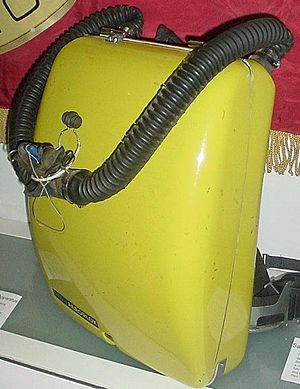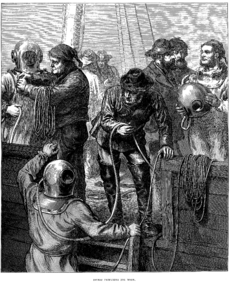Siebe Gorman facts for kids

Siebe Gorman Aerorlox oxygen rebreather
|
|
| Successor | Air Master Technology Limited |
|---|---|
| Founder | Augustus Siebe |
| Defunct | April 9, 2019 |
| Headquarters |
United Kingdom
|
Siebe Gorman & Company Ltd was a British company that made special equipment for diving and breathing. They were known as 'Submarine Engineers' and worked on big underwater projects like commercial diving and finding sunken ships (marine salvage). The company was started by Augustus Siebe, an engineer from Germany who became famous for his inventions in diving.
Later, in the 1970s, the company grew and became Siebe plc. This new, larger company took over other businesses. Siebe plc became one of the biggest engineering companies in the United Kingdom. It was even part of the FTSE 100 Index, which lists the top 100 companies in the UK. In 1999, Siebe plc joined with another company called BTR plc to form Invensys. Invensys was later bought by a French company, Schneider Electric, in 2014.
Contents
Company Story
- 1788: Augustus Siebe was born in Germany. He learned how to work with brass.
- 1815: He was an officer in the Prussian army at the Battle of Waterloo.
- 1816: After the war, he moved to London, England. He worked as a watchmaker, gunmaker, and then an instrument maker. He became an engineer.
- 1819: He started his own engineering business in London. He made many different machines, not just diving gear.
- 1830: His daughter Mary Siebe was born. Around this time, the company, which later became Siebe Gorman, created its first diving helmet.
Making Diving Gear
- 1830: Two brothers, John and Charles Deane, asked Siebe to make a special helmet for underwater use. This led Siebe to create his own improved diving helmet. It was attached to a full, waterproof canvas diving suit (called a standard diving dress). A special valve in the helmet made the equipment work really well.
- 1856: Augustus Siebe became a British citizen.
- 1868: He retired due to old age and poor health.
- 1870: Augustus Siebe passed his business to his son, Henry Herapath Siebe, and to William Augustus Gorman. The company became known as 'Siebe & Gorman'.
- 1872: Augustus Siebe died.
- 1878: A man named Henry Fleuss, with help from Siebe Gorman, designed a useful oxygen rebreather. This was a device that let divers breathe their own air again after it was cleaned.
- 1880: The company's name changed to Siebe Gorman & Co.
- 1882: Robert Henry Davis joined Siebe Gorman as a young office boy. He learned a lot and became very skilled in making breathing equipment.
- 1894: Robert Davis was promoted to General Manager of Siebe Gorman.
The 20th Century
- 1904: William Augustus Gorman died. The company became a new private company called 'Siebe Gorman & Co. Ltd.'.
- 1907: The Admiralty (the British Navy) asked Siebe Gorman to help create better deep-diving equipment. The company started making the Siebe Gorman Proto industrial rebreather.
- 1932: King George V made Robert Davis a knight (Sir Robert Davis). This was mainly because he invented the Davis Submerged Escape Apparatus, which helped people escape from sunken submarines.
- 1938: Robert Davis bought land in Tolworth, Surrey, to build a bigger factory. The new building was called Neptune Works.
World War II
- 1938-1939: Siebe Gorman made thousands of gas masks for civilians and civil defense during World War II.
- 1941: Siebe Gorman's factory in London was bombed during the war. Many company records were lost.
- 1941: The company moved its manufacturing to Chessington, Surrey.
- 1943: Siebe Gorman designed special equipment for tank crews called the Amphibious Tank Escape Apparatus (ATEA). This allowed tank crews to breathe underwater for up to 7 minutes if their tanks sank. It helped save many lives, especially during D-Day.
After World War II
- 1948: Siebe Gorman started making "aqualungs", which are modern scuba diving sets.
- 1952: Siebe Gorman became a limited company. Robert Davis became its managing director.
- 1954: Siebe Gorman began making aqualungs for both commercial and sport diving. They also made diving suits, swim fins, and dive masks.
- 1959: The Fairey Aviation Company took over Siebe Gorman.
- 1960s: Siebe Gorman continued to make scuba gear for the public, often using the names Essgee and Essjee. They also made diving bell equipment.
- 1961: Siebe Gorman took over another diving gear company called Heinke.
- 1965: Robert Davis died at age 94. Siebe Gorman helped with the underwater scenes for the James Bond film Thunderball.
- 1967-1968: Siebe Gorman stopped using the name 'Siebe Heinke'. Around this time, Siebe plc began to grow as a larger company, separate from Siebe Gorman's original diving business.
- 1975: Siebe Gorman moved to Cwmbran in Wales and focused on making firefighter's breathing equipment.
- 1998: Siebe plc sold Siebe Gorman to another company called Norcross.
- 1999: Norcross sold what was Siebe Gorman to an Iranian businessman. The company was renamed Air Master Technology Limited (AMtec).
The 21st Century
- 2000: Air Master Technology moved to Swindon in Wiltshire.
- 2001: Air Master Technology stopped trading.
- 2001: The name Siebe Gorman and its assets were sold to a Malaysian company. This company, "Siebe Gorman Sdn. Bhd.", still makes breathing apparatus today.
- 2019: Siebe Gorman & Company was officially closed down.
What They Made
The company was famous for creating the "closed" diving helmet for the standard diving dress. This helmet was sealed to the diving suit, making it waterproof. This was a big improvement over older, open helmets. This new equipment was much safer and worked better, changing underwater work from the 1830s onwards.
A British Navy leader, Colonel Charles Pasley, suggested that the helmet should be able to detach from the suit. This led to the typical standard diving dress that changed underwater civil engineering, salvage, commercial diving, and naval diving.
Siebe Gorman mainly made standard diving suit equipment, including copper and brass diving helmets. During World War 2, they also made frogman's equipment for the British armed forces. Later, they made scuba gear for sport divers.
Siebe Gorman Products
Breathing Equipment
Here are some of the breathing devices they made for military, civilian, diving, and non-diving use:
- Aerorlox (for mine rescue)
- Universal Rebreather or CDBA (for clearance divers)
- DSEA Siebe Gorman (for escaping from submarines)
- Fleuss-Davis SCUBA apparatus
- Lungovox (a small industrial oxygen rebreather)
- Minox
- Proto (a well-known rebreather)
- Salvus A.N.S
- Sladen suit (used by British human torpedo crews)
Other Items
- Air lock diving-bell plant (equipment for working underwater in a bell)
- Gasmasks
- Drysuits (called "Frogman" suits when sold to the public)
- The Bragg-Paul Pulsator (a medical ventilator)
Images for kids



